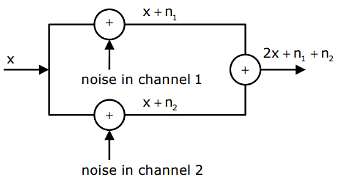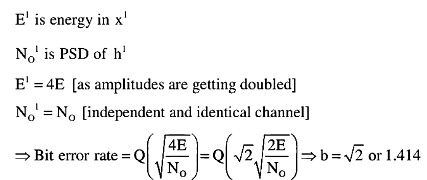Electronics and Communication Engineering (ECE) Exam > Electronics and Communication Engineering (ECE) Questions > Let Q√γ be the BER of a BPSK syst...
Start Learning for Free
Let Q√γ be the BER of a BPSK system over an AWGN channel with twosided noise power spectral density N0/2. The parameter γ is a function of bit energy and noise power spectral density.
A system with two independent and identical AWGN channels with noise power spectral density N0/2 is shown in the figure. The BPSK demodulator receives the sum of outputs of both the channels.

BER of this system is Q(b√γ ), then the value of b is ________.(Answer up to three decimal places)
Correct answer is '1.414'. Can you explain this answer?
| FREE This question is part of | Download PDF Attempt this Test |
Most Upvoted Answer
Let Q√γ be the BER of a BPSK system over an AWGN channel w...
Bit error rate for BPSK

⇒ Y = 2E/No
Function of bit energy and noise 

Counterllation diagram of BPSK
Channel is AWGN which implies noise sample as independent
Let 2x +n1+ n2 = x1 + n1
where x1 = 2x
n1 = n1 + n2



E1 is energy in x1
No1 is PSD of h1
E1 = 4E [as amplitudes are getting doubled]
No1 = No [independent and identical channel]

Attention Electronics and Communication Engineering (ECE) Students!
To make sure you are not studying endlessly, EduRev has designed Electronics and Communication Engineering (ECE) study material, with Structured Courses, Videos, & Test Series. Plus get personalized analysis, doubt solving and improvement plans to achieve a great score in Electronics and Communication Engineering (ECE).

|
Explore Courses for Electronics and Communication Engineering (ECE) exam
|

|
Similar Electronics and Communication Engineering (ECE) Doubts
Let Q√γ be the BER of a BPSK system over an AWGN channel with twosided noise power spectral density N0/2. The parameter γ is a function of bit energy and noise power spectral density.A system with two independent and identical AWGN channels with noise power spectral density N0/2 is shown in the figure. The BPSK demodulator receives the sum of outputs of both the channels.BER of this system is Q(b√γ ), then the value of b is ________.(Answer up to three decimal places)Correct answer is '1.414'. Can you explain this answer?
Question Description
Let Q√γ be the BER of a BPSK system over an AWGN channel with twosided noise power spectral density N0/2. The parameter γ is a function of bit energy and noise power spectral density.A system with two independent and identical AWGN channels with noise power spectral density N0/2 is shown in the figure. The BPSK demodulator receives the sum of outputs of both the channels.BER of this system is Q(b√γ ), then the value of b is ________.(Answer up to three decimal places)Correct answer is '1.414'. Can you explain this answer? for Electronics and Communication Engineering (ECE) 2024 is part of Electronics and Communication Engineering (ECE) preparation. The Question and answers have been prepared according to the Electronics and Communication Engineering (ECE) exam syllabus. Information about Let Q√γ be the BER of a BPSK system over an AWGN channel with twosided noise power spectral density N0/2. The parameter γ is a function of bit energy and noise power spectral density.A system with two independent and identical AWGN channels with noise power spectral density N0/2 is shown in the figure. The BPSK demodulator receives the sum of outputs of both the channels.BER of this system is Q(b√γ ), then the value of b is ________.(Answer up to three decimal places)Correct answer is '1.414'. Can you explain this answer? covers all topics & solutions for Electronics and Communication Engineering (ECE) 2024 Exam. Find important definitions, questions, meanings, examples, exercises and tests below for Let Q√γ be the BER of a BPSK system over an AWGN channel with twosided noise power spectral density N0/2. The parameter γ is a function of bit energy and noise power spectral density.A system with two independent and identical AWGN channels with noise power spectral density N0/2 is shown in the figure. The BPSK demodulator receives the sum of outputs of both the channels.BER of this system is Q(b√γ ), then the value of b is ________.(Answer up to three decimal places)Correct answer is '1.414'. Can you explain this answer?.
Let Q√γ be the BER of a BPSK system over an AWGN channel with twosided noise power spectral density N0/2. The parameter γ is a function of bit energy and noise power spectral density.A system with two independent and identical AWGN channels with noise power spectral density N0/2 is shown in the figure. The BPSK demodulator receives the sum of outputs of both the channels.BER of this system is Q(b√γ ), then the value of b is ________.(Answer up to three decimal places)Correct answer is '1.414'. Can you explain this answer? for Electronics and Communication Engineering (ECE) 2024 is part of Electronics and Communication Engineering (ECE) preparation. The Question and answers have been prepared according to the Electronics and Communication Engineering (ECE) exam syllabus. Information about Let Q√γ be the BER of a BPSK system over an AWGN channel with twosided noise power spectral density N0/2. The parameter γ is a function of bit energy and noise power spectral density.A system with two independent and identical AWGN channels with noise power spectral density N0/2 is shown in the figure. The BPSK demodulator receives the sum of outputs of both the channels.BER of this system is Q(b√γ ), then the value of b is ________.(Answer up to three decimal places)Correct answer is '1.414'. Can you explain this answer? covers all topics & solutions for Electronics and Communication Engineering (ECE) 2024 Exam. Find important definitions, questions, meanings, examples, exercises and tests below for Let Q√γ be the BER of a BPSK system over an AWGN channel with twosided noise power spectral density N0/2. The parameter γ is a function of bit energy and noise power spectral density.A system with two independent and identical AWGN channels with noise power spectral density N0/2 is shown in the figure. The BPSK demodulator receives the sum of outputs of both the channels.BER of this system is Q(b√γ ), then the value of b is ________.(Answer up to three decimal places)Correct answer is '1.414'. Can you explain this answer?.
Solutions for Let Q√γ be the BER of a BPSK system over an AWGN channel with twosided noise power spectral density N0/2. The parameter γ is a function of bit energy and noise power spectral density.A system with two independent and identical AWGN channels with noise power spectral density N0/2 is shown in the figure. The BPSK demodulator receives the sum of outputs of both the channels.BER of this system is Q(b√γ ), then the value of b is ________.(Answer up to three decimal places)Correct answer is '1.414'. Can you explain this answer? in English & in Hindi are available as part of our courses for Electronics and Communication Engineering (ECE).
Download more important topics, notes, lectures and mock test series for Electronics and Communication Engineering (ECE) Exam by signing up for free.
Here you can find the meaning of Let Q√γ be the BER of a BPSK system over an AWGN channel with twosided noise power spectral density N0/2. The parameter γ is a function of bit energy and noise power spectral density.A system with two independent and identical AWGN channels with noise power spectral density N0/2 is shown in the figure. The BPSK demodulator receives the sum of outputs of both the channels.BER of this system is Q(b√γ ), then the value of b is ________.(Answer up to three decimal places)Correct answer is '1.414'. Can you explain this answer? defined & explained in the simplest way possible. Besides giving the explanation of
Let Q√γ be the BER of a BPSK system over an AWGN channel with twosided noise power spectral density N0/2. The parameter γ is a function of bit energy and noise power spectral density.A system with two independent and identical AWGN channels with noise power spectral density N0/2 is shown in the figure. The BPSK demodulator receives the sum of outputs of both the channels.BER of this system is Q(b√γ ), then the value of b is ________.(Answer up to three decimal places)Correct answer is '1.414'. Can you explain this answer?, a detailed solution for Let Q√γ be the BER of a BPSK system over an AWGN channel with twosided noise power spectral density N0/2. The parameter γ is a function of bit energy and noise power spectral density.A system with two independent and identical AWGN channels with noise power spectral density N0/2 is shown in the figure. The BPSK demodulator receives the sum of outputs of both the channels.BER of this system is Q(b√γ ), then the value of b is ________.(Answer up to three decimal places)Correct answer is '1.414'. Can you explain this answer? has been provided alongside types of Let Q√γ be the BER of a BPSK system over an AWGN channel with twosided noise power spectral density N0/2. The parameter γ is a function of bit energy and noise power spectral density.A system with two independent and identical AWGN channels with noise power spectral density N0/2 is shown in the figure. The BPSK demodulator receives the sum of outputs of both the channels.BER of this system is Q(b√γ ), then the value of b is ________.(Answer up to three decimal places)Correct answer is '1.414'. Can you explain this answer? theory, EduRev gives you an
ample number of questions to practice Let Q√γ be the BER of a BPSK system over an AWGN channel with twosided noise power spectral density N0/2. The parameter γ is a function of bit energy and noise power spectral density.A system with two independent and identical AWGN channels with noise power spectral density N0/2 is shown in the figure. The BPSK demodulator receives the sum of outputs of both the channels.BER of this system is Q(b√γ ), then the value of b is ________.(Answer up to three decimal places)Correct answer is '1.414'. Can you explain this answer? tests, examples and also practice Electronics and Communication Engineering (ECE) tests.

|
Explore Courses for Electronics and Communication Engineering (ECE) exam
|

|
Suggested Free Tests
Signup for Free!
Signup to see your scores go up within 7 days! Learn & Practice with 1000+ FREE Notes, Videos & Tests.
























